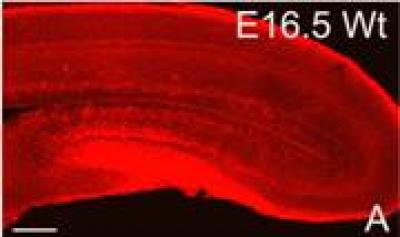Cajal-Retzius cell loss and amyloidosis in Alzheimer's disease

Cajal-Retzius cells were observed in the molecular layer of the dentate gyrus as early as embryonic day 16.5, and were densely concentrated in the molecular layer of the dentate gyrus (immunohistochemical analysis). Credit: Neural Regeneration Research
However, the relationship between Cajal-Retzius cells and Alzheimer's disease is unknown.
Dr. Jinbo Deng and team from Henan University in China revealed that the number of Cajal-Retzius cells markedly reduced with age in both wild type and in mice over-expressing the Swedish double mutant form of amyloid precursor protein 695 (transgenic (Tg) 2576 mice).
The decline in Cajal-Retzius cells in Tg2576 mice was found to occur concomitantly with the onset of Alzheimer's disease amyloid pathology and related behavioral defcits.
Overall, these data, published in the Neural Regeneration Research (Vol. 9, No. 4, 2014), indicated that Cajal-Retzius cell loss occurred with the onset and development of Alzheimer's disease.
Article: ” Characterization of hippocampal Cajal-Retzius cells during development in a mouse model of Alzheimer's disease (Tg2576),” by Dongming Yu1, Wenjuan Fan2, Ping Wu1, Jiexin Deng1, Jing Liu1, Yanli Niu1, Mingshan Li1, Jinbo Deng1 (1 Institute of Neurobiology, School of Life Science, Henan University, Kaifeng, Henan Province, China; 2 Laboratory of Molecular Medicine, Luohe Medical College, Luohe, Henan Province, China)
Yu DM, Fan WJ, Wu P, Deng JX, Liu J, Niu YL, Li MS, Deng JB. Characterization of hippocampal Cajal-Retzius cells during development in a mouse model of Alzheimer's disease (Tg2576). Neural Regen Res. 2014;9(4):394-401.
Contact:
Meng Zhao
eic@nrren.org
86-138-049-98773
Neural Regeneration Research
http://www.nrronline.org/
Media Contact
All latest news from the category: Life Sciences and Chemistry
Articles and reports from the Life Sciences and chemistry area deal with applied and basic research into modern biology, chemistry and human medicine.
Valuable information can be found on a range of life sciences fields including bacteriology, biochemistry, bionics, bioinformatics, biophysics, biotechnology, genetics, geobotany, human biology, marine biology, microbiology, molecular biology, cellular biology, zoology, bioinorganic chemistry, microchemistry and environmental chemistry.
Newest articles

Sea slugs inspire highly stretchable biomedical sensor
USC Viterbi School of Engineering researcher Hangbo Zhao presents findings on highly stretchable and customizable microneedles for application in fields including neuroscience, tissue engineering, and wearable bioelectronics. The revolution in…

Twisting and binding matter waves with photons in a cavity
Precisely measuring the energy states of individual atoms has been a historical challenge for physicists due to atomic recoil. When an atom interacts with a photon, the atom “recoils” in…

Nanotubes, nanoparticles, and antibodies detect tiny amounts of fentanyl
New sensor is six orders of magnitude more sensitive than the next best thing. A research team at Pitt led by Alexander Star, a chemistry professor in the Kenneth P. Dietrich…





















